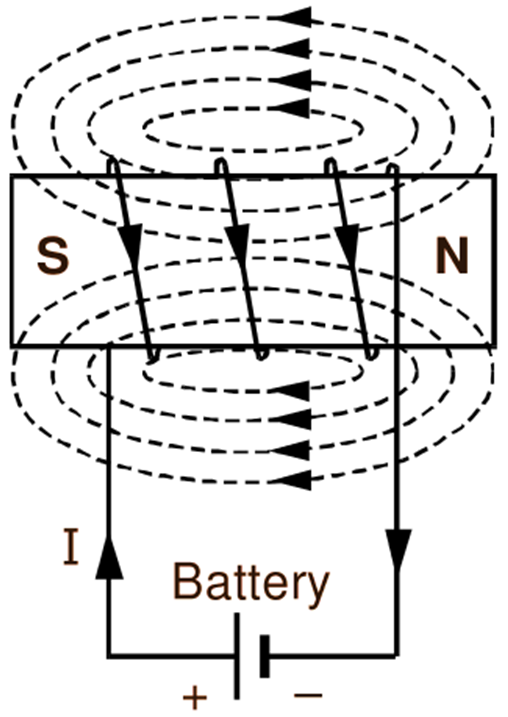In this topic, you study Magnetic Field Due to Solenoid.
When a long conductor is wound with number of turns close together to form a coil whose axial length is several times greater than the diameter of its turns, it is known as a solenoid. It may be air cored or wound on long tubular core of magnetic or non-magnetic material (Fig. 1 a). A solenoid using circular core instead of long tubular core is called a toroid. When the current is passed through the solenoid, the magnetic field produced by it acts through the coil along its axis and in the space around the solenoid. Use of iron core intensifies the magnetic field of the solenoid. This is because when the current carrying solenoid is provided with an Iron core, the core is acted upon by the original magnetic field and becomes a magnet by the process of magnetic induction.

(a)

(b)
Fig. 1: (a) Solenoid with iron core (b) End rule for finding polarity
As such, it sets up magnetic lines of force of its own. These induced lines of force in the core being in the same direction as the lines of original magnetic field, in effect, the resultant field of the solenoid becomes stronger. Looking at the field pattern, it will be observed that the magnetic field of a solenoid is similar to that of a bar magnet. The polarity of the solenoid may be obtained by means of the following rules:
The Right Hand in Rule
Grip the solenoid in the right hand with the fingers pointing in the direction of the current. The thumb outstretched parallel to the axis of the solenoid then points to the North pole of the solenoid.
The End Rule
The polarity may be determined by looking at the solenoid from any one end and noting the direction of the current (Fig. 1 b).
The Corkscrew Rule
If the axis of the right handed screw is placed along that of the solenoid and if the screw is turned in the direction of the current, it travels in the direction of the magnetic field inside the solenoid i.e. towards the North le of the solenoid.
Magnetic Field Strength Inside a Long Solenoid
The magnetic field strength along the axis of a solenoid is a function of the number of turns of the coil and the magnitude of the current flowing through it and is given by the following expression:
\[\text{H}=\frac{\text{NI}}{\text{l}}\]
where
N = Number of turns of a solenoid
I = Current, in amperes
l = Length of the solenoid, in metres.
The unit of magnetic field strength (H) is newtons/weber or amperes/meter.